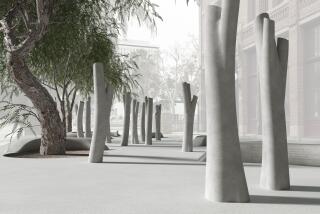Forbidden City Exhibit Allows for a Bit of History
KATY, Texas -- Thirty miles west of the steel and glass of Houston, rice fields flourish alongside new tract home developments. Land is cheap, plentiful and relatively free of red tape -- which goes a long way toward explaining how a 40-acre, $16-million miniaturized replica of China’s Forbidden City came to be built here by a reclusive Seattle millionaire named Ira Poon.
“Mr. Poon was born and raised in Hong Kong and wanted to pay respect to his culture and America,” said Melinda Schmidt, director of Forbidden Gardens, as this intricately conceived homage to imperial China is called. “When his children started school in Seattle, he realized you learned very little about world history. So he decided to build an educational museum.”
Poon’s good intentions haven’t exactly caught fire with the neighbors here. It’s not that they haven’t noticed the orange pagodas rising from the Texas prairie -- it’s impossible not to. But “people don’t know what it’s for,” said Tommy Cassidy, 22, a museum maintenance worker. “Lots of people think it’s a Chinese restaurant. To tell you the truth, so did I until I started working here.”
The Forbidden City, in the heart of Beijing, is a legendary complex of palaces that served Chinese emperors and scholars from 1420 to 1911.
The Texas version, which opened in 1996 down the road from a Dollar Store, is a faithful reproduction 1/20th the size of the original. A 40,000-square-foot outdoor pavilion shelters a series of intricate, doll-size palaces populated by hundreds of ceramic figurines.
Loyal Guards
An equally ambitious companion exhibit reproduces the tomb of Emperor Qin (pronounced “chin” -- “China” is derived from his name). Here, a huge earthen pit holds 6,000 half-size terra cotta soldiers standing guard in long, neat rows.
The entrance to the crypt is guarded by two marble half-man, half-dog creatures that employees have dubbed Harry and Larry.
Originally, every piece on display at the museum was handcrafted by artisans in China and shipped to the Port of Houston. Poon insisted on authenticity. The clay used to make his terra cotta soldiers came from the Chinese province that produced the originals. The palaces of the Forbidden City are painstakingly re-created with carved dragons on the roofs, hand-painted tiles and wooden screens. The ceramic figures of royalty, guards and concubines are dressed in beautifully painted robes, uniforms and kimonos.
But for all the expense and planning, the designers evidently forgot one important detail: Houston’s steam-bath climate. The sun and humidity here have damaged some of the outdoor displays beyond repair -- splintering wood, cracking clay figures and buckling foundations never meant to withstand the punishing Texas heat.
“I think the Chinese craftsmen were looking at it from an artist’s perspective, not how it would hold up in the kind of weather we have here,” said Marian Schmidt, the museum’s assistant director and Melinda’s mother.
Renovations began two months ago, and the small staff here is doing what it can on what the younger Schmidt calls “a shoestring budget.” Maintenance workers like Cassidy are repainting cracked palace walls and reinforcing sagging roofs.
They spent days gluing heads and arms back onto the crumbling clay soldiers guarding Emperor Qin’s tomb. Each soldier originally held a weapon -- fingers curled inward, thumb pointing skyward -- that were lost to the sun. Now thousands of clay soldiers stand empty-handed, giving the emperor a cheerful thumbs-up.
Cassidy brightened the gardens of several imperial palaces with tiny, homemade cherry blossom and bonsai trees he purchased at a craft store.
“We went down to the Hobby Lobby and got a lot of cheap stuff, like fake flowers, and put it all together,” he said. “It was like being in home-ec in high school.”
Periodic Checks
Every so often, Poon’s representatives come here to check on the operation. The mysterious Poon hasn’t made an appearance in two years, Melinda Schmidt said. “He’s quiet and soft-spoken. He may be in his 60s. I think he made his fortune in real estate in Hong Kong or Seattle.”
Beyond that, Schmidt knows little about her employer.
“We mainly deal with his representatives. I don’t even know a number to call for Mr. Poon,” she said.
Between 125,000 and 200,000 people visit the museum each year, said Schmidt, who said museum officials were disappointed in the attendance and attributed it, in part, to the delayed opening of a nearby freeway. Most attendees are schoolchildren on field trips.
They pay $5 a head to get in; adult admission is $10.
On a recent day, Arty Gladstone, a visitor from Florida, stopped to gaze at the maze of tiny palaces.
“It’s cute, but it ain’t the real thing,” said Gladstone, 74, who said he has toured China several times with his wife.
But on closer inspection, he reassessed.
“When you’re going through the real thing, it’s so immense you lose perspective,” he said. “Looking at this, you get a better sense of what it’s all about.”
More to Read
Sign up for The Wild
We’ll help you find the best places to hike, bike and run, as well as the perfect silent spots for meditation and yoga.
You may occasionally receive promotional content from the Los Angeles Times.






